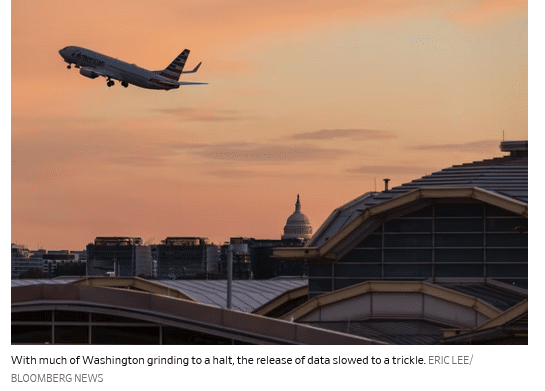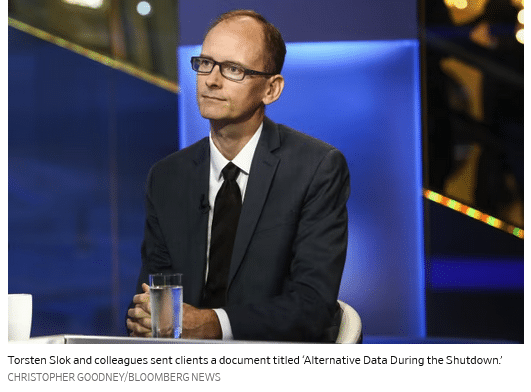Professional forecasters learned to sleep past 5 a.m. and ask their plumber for clues about the U.S. economy; ‘It’s a little sad.’

This past Friday, labor economist Guy Berger got to sleep in for the second month in a row. He wasn’t happy about it.
The government shutdown meant there was no jobs report from the Bureau of Labor Statistics. So instead of waking in the dark at 5 a.m. in California to be ready for the release of the report, Berger got up a few hours later and spent the morning drinking coffee and eating yogurt.
“It’s a little sad,” Berger said of the missing jobs data. “I will be very happy when the BLS data comes back.”
He may get his wish soon. Senators on Monday passed a spending package to end the record-long government shutdown. The package now moves to the House for a final vote as soon as Wednesday.
For the past six weeks, Berger and his peers have searched for meaning wherever they could find it. For some, that’s meant tracking obscure metrics like visits to the Statue of Liberty. Others used the shutdown to dust off esoteric research projects. One economist said he asked his plumber how tariffs are affecting his business when he came to do work in his home.

Economists have long planned their professional and personal lives around the regular morning government data releases that occur throughout a typical month. Though private-sector economists have continued to be paid as usual, unlike the federal workers who missed paychecks, they say it’s been hard to decipher the direction of the economy.
“My assembly line of data that comes through just is getting thinner and thinner. So that’s why in desperation, I have gone out and looked at indicators that I would not normally spend too much time on,” said Torsten Slok, chief economist at Apollo Global Management.
It’s not just the monthly jobs report they’ve been missing. The government puts out regular data on everything from exports of excavating machinery to sales at shoe stores.
“The data dogs are howling because we’re not getting our usual supply of information,” Chicago Fed President Austan Goolsbee, who has used the canine term to refer to himself in the past, said in a radio interview that aired Oct. 1.
Like others, Goolsbee has looked for new sources. “One of the key rules of the data dogs is, sniff every piece of data that hits the floor, because it might be food,” he said. The Chicago Fed continued to publish its own labor market data during the shutdown. Economists have also long followed some private sources of data like payroll firm ADP’s jobs figures.
Fed Chair Jerome Powell said in late October that the dearth of comprehensive statistics—along with piecemeal surveys and anecdotes showing no major deterioration in the outlook—could make the central bank more cautious about further rate cuts. “What do you do if you’re driving in the fog? You slow down.” he said.
A few days after the government closed, Slok and two colleagues sent clients a 75-page document titled “Alternative Data During the Shutdown.” It included slides on visits to the Statue of Liberty and Broadway show attendance, metrics they believe could reflect discretionary spending. There’s a slide on movie attendance sourced to Boxofficemojo.com.


“It is like circumstantial evidence in a Sherlock Holmes mystery,” said Slok. “I do not know whether things have been getting better or not, but I have a lot of small pieces of evidence that I find on my way as I walk forward.”
Economist Don Rissmiller of Strategas hasn’t missed an inflation or jobs report in nearly three decades. He closely follows the other, more minor releases, too. “You have a hole between 6:30 a.m. and 10:30 a.m. every day. It’s hard to fill completely,” Rissmiller said.
He’s wary of turning to anecdotal data, like his own personal observations or even the Fed’s Beige Book that compiles feedback from local businesses and others. “You’re at the mall, does it look busy? You’re asking the taxi driver, ‘Is there anything going on in town?’” he said. “It’s easy to get carried away with a few negative anecdotes.”

His team has been dusting off some research that they may not have gotten to without the shutdown. His colleague Maria Cabella sent clients a note about stablecoins that began with a Latin proverb and a first-person recollection about her college roommate.
Much of the data for the September jobs report was collected before the shutdown, so it could be released relatively quickly if the government reopens, Berger said.
Even if the government reopens soon, the jobs report may not go back to normal until the December report, scheduled for release in early January. The data were never collected for the October report—and an important portion of the data for the November report was supposed to be collected this week. The shutdown itself could skew the employment figures too.
The bill headed to the House would fund the government through Jan 30. “Assuming nothing crazy happens, by early January we’ll have a pretty good idea about the job market. Then there’s the question of if we’ll have another shutdown,” Berger said.
Read the full article HERE.


